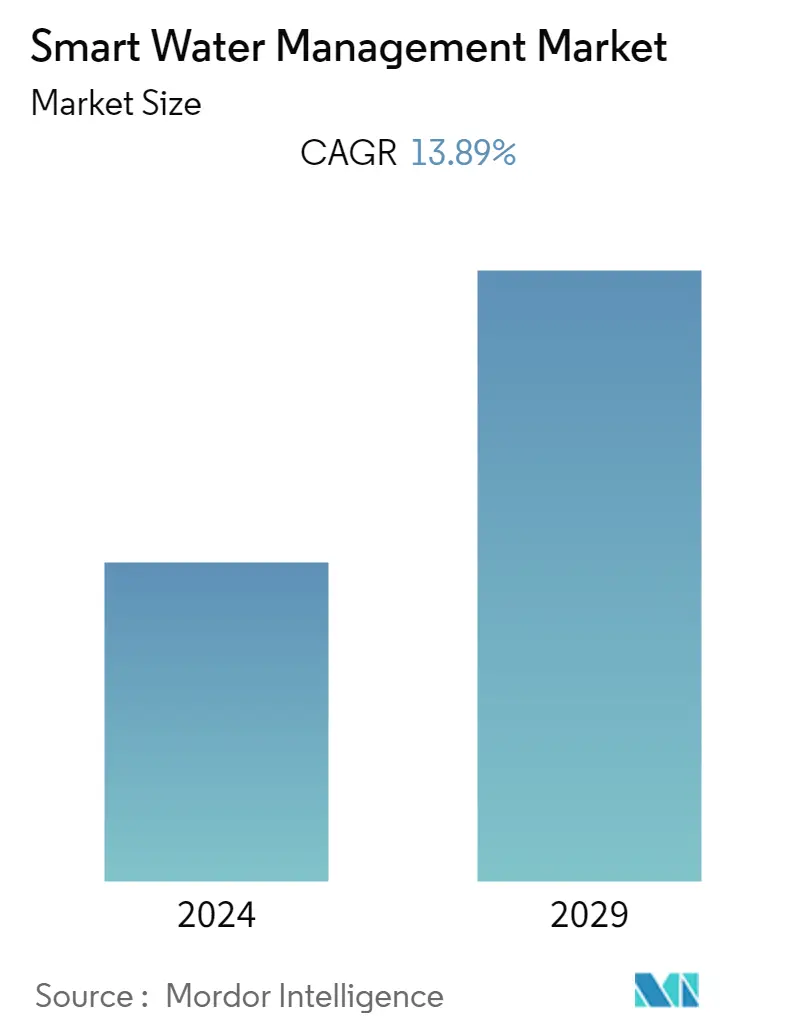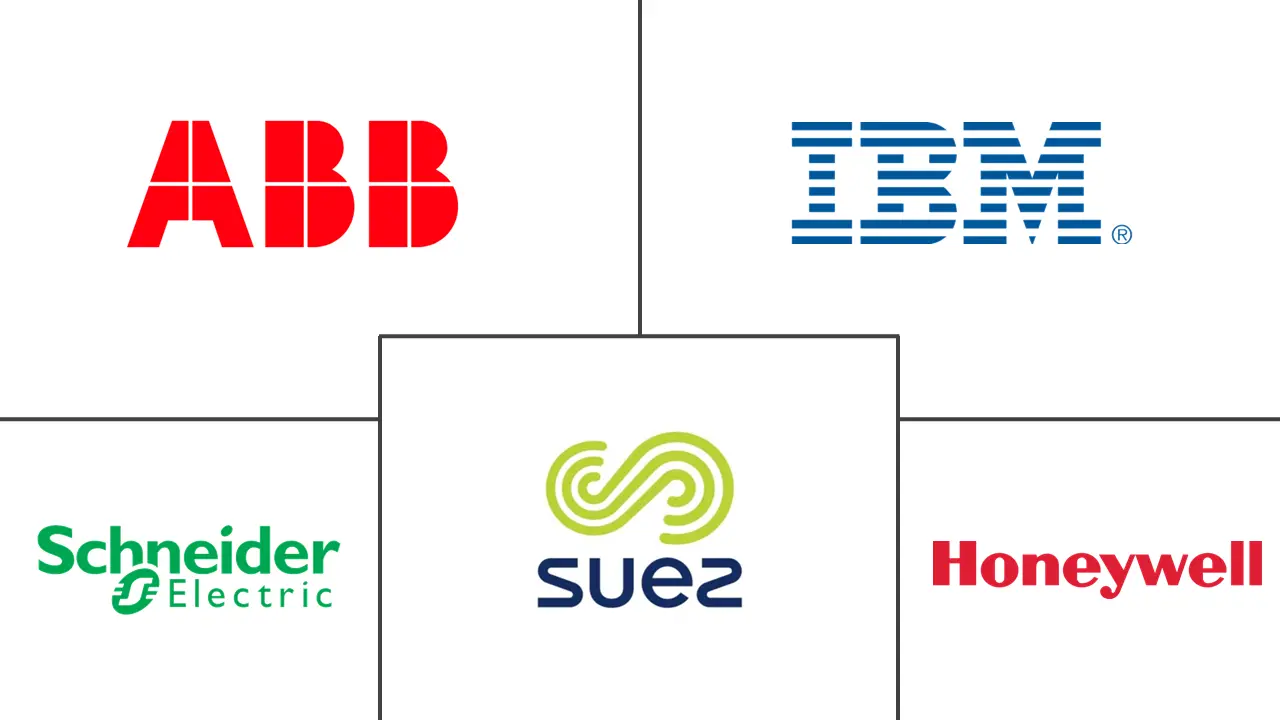Market Size of Smart Water Management Industry

| Study Period | 2019 - 2029 |
| Base Year For Estimation | 2023 |
| CAGR | 13.89 % |
| Fastest Growing Market | Asia Pacific |
| Largest Market | Asia Pacific |
| Market Concentration | Medium |
Major Players
*Disclaimer: Major Players sorted in no particular order |
Smart Water Management Market Analysis
The Smart Water Management Market size is expected to grow from USD 16.08 billion in 2023 to USD 30.80 billion by 2028, registering a CAGR of 13.89% during the forecast period. In recent years, owing to increasing population and urbanization, the global demand for water and the need to address the cost implications of maintaining an aging infrastructure has been the major growth factors for the smart water management market.
- Smart water management (SWM) uses information and communication technology (ICT) and real-time data and responses, which is an integral part of the solution for water management challenges. The potential application of smart systems in water management is vast and includes solutions for water quality, water quantity, efficient irrigation, leaks, pressure and flow, floods, droughts, and more.
- Smart data-driven methods for detecting water losses in public networks are becoming popular. Such solutions are based on applying the Internet of Things (IoT) and artificial intelligence (AI) techniques. In the State of Palestine, the UNDP/PAPP's Accelerator Lab partnered with a promising start-up company, FlowLess, to test a locally developed and cost-efficient smart system for detecting water losses using IoT and AI, supported by a customized web platform.
- Water infrastructure costs need to be assessed across the full water cycle and for all its major uses. As 2030 approaches, the costs of operating a new infrastructure built may exceed the annual capital cost requirements to meet those remaining unserved. When coupled with increased billing accuracy, the short-term issues in investing in smart water metering highlight a higher initial capital outlay. Traditional water management users are reluctant to switch to newer and advanced methods. The high initial cost of infrastructure and training prevails in most developing nations, hindering the market's growth.
- Post-COVID-19 pandemic, European countries focused on investing in water loss solutions. The European Union has invested in research and innovation to support a smooth transition. 79% of citizens agree that tackling climate change may lead to innovation that may make European companies more competitive, and 70% agree that water-based activity may positively affect citizens.
Smart Water Management Industry Segmentation
Smart water management is a technology that collects, shares, and analyzes data from water equipment and networks. Water managers use it to find leaks, lower energy usage, conserve water, predict equipment failure, and ensure regulatory compliance.
The smart water management market is segmented by type (solution (asset management, distribution network monitoring, SCADA, meter data management, analytics), services (managed services/professional services)), end-user vertical (residential, commercial, and industrial), and geography (North America, Europe, Asia-Pacific, Latin America, and Middle East & Africa). The market sizes and forecasts are provided in terms of value in USD for all the above segments.
| By Type | ||||||||
| ||||||||
| By Services - Managed/Professional |
| By End User | |
| Residential | |
| Commercial | |
| Industrial |
| By Geography | |
| North America | |
| Europe | |
| Asia-Pacific | |
| Latin America | |
| Middle East and Africa |
Smart Water Management Market Size Summary
The Smart Water Management Market is poised for significant expansion, driven by the increasing global demand for efficient water management solutions due to population growth and urbanization. The integration of information and communication technology (ICT) with real-time data is central to addressing challenges such as water quality, quantity, and infrastructure maintenance. The adoption of smart systems, including IoT and AI, is gaining traction for detecting water losses and optimizing water distribution. However, the transition from traditional methods to advanced solutions faces hurdles, particularly in developing regions where high initial costs and training requirements pose barriers. Despite these challenges, the market is witnessing a surge in interest and investment, particularly in Europe and Asia-Pacific, where governments and companies are actively pursuing innovative water management strategies.
The market landscape is characterized by a mix of established global players and emerging companies, all vying for a share in this rapidly growing sector. Recent developments include strategic acquisitions and investments aimed at enhancing technological capabilities and expanding market reach. The focus on sustainability and climate resilience is driving initiatives such as digital water data banks and smart water management platforms, which are becoming increasingly popular in regions with significant non-revenue water losses. As consumers and businesses alike embrace digitization and connected technologies, the demand for smart water management solutions is expected to rise, offering lucrative opportunities for market participants to consolidate their offerings and introduce advanced products.
Smart Water Management Market Size - Table of Contents
-
1. MARKET INSIGHTS
-
1.1 Market Overview
-
1.2 Industry Attractiveness - Porter's Five Forces Analysis
-
1.2.1 Bargaining Power of Suppliers
-
1.2.2 Bargaining Power of Buyers
-
1.2.3 Threat of New Entrants
-
1.2.4 Intensity of Competitive Rivalry
-
1.2.5 Threat of Substitute Products and Services
-
-
1.3 Industry Value Chain Analysis
-
1.4 Impact of COVID-19 on the Market
-
-
2. MARKET SEGMENTATION
-
2.1 By Type
-
2.1.1 By Solution
-
2.1.1.1 Asset Management
-
2.1.1.2 Distribution Network Monitoring
-
2.1.1.3 Supervisory Control and Data Acquisition (SCADA)
-
2.1.1.4 Meter Data Management (MDM)
-
2.1.1.5 Analytics
-
2.1.1.6 Other Solutions
-
-
2.1.2 By Services - Managed/Professional
-
-
2.2 By End User
-
2.2.1 Residential
-
2.2.2 Commercial
-
2.2.3 Industrial
-
-
2.3 By Geography
-
2.3.1 North America
-
2.3.2 Europe
-
2.3.3 Asia-Pacific
-
2.3.4 Latin America
-
2.3.5 Middle East and Africa
-
-
Smart Water Management Market Size FAQs
What is the current Smart Water Management Market size?
The Smart Water Management Market is projected to register a CAGR of 13.89% during the forecast period (2024-2029)
Who are the key players in Smart Water Management Market?
ABB Ltd, IBM Corporation, SUEZ Group , Honeywell International Inc. and Schneider Electric SE (+AVEVA) are the major companies operating in the Smart Water Management Market.

